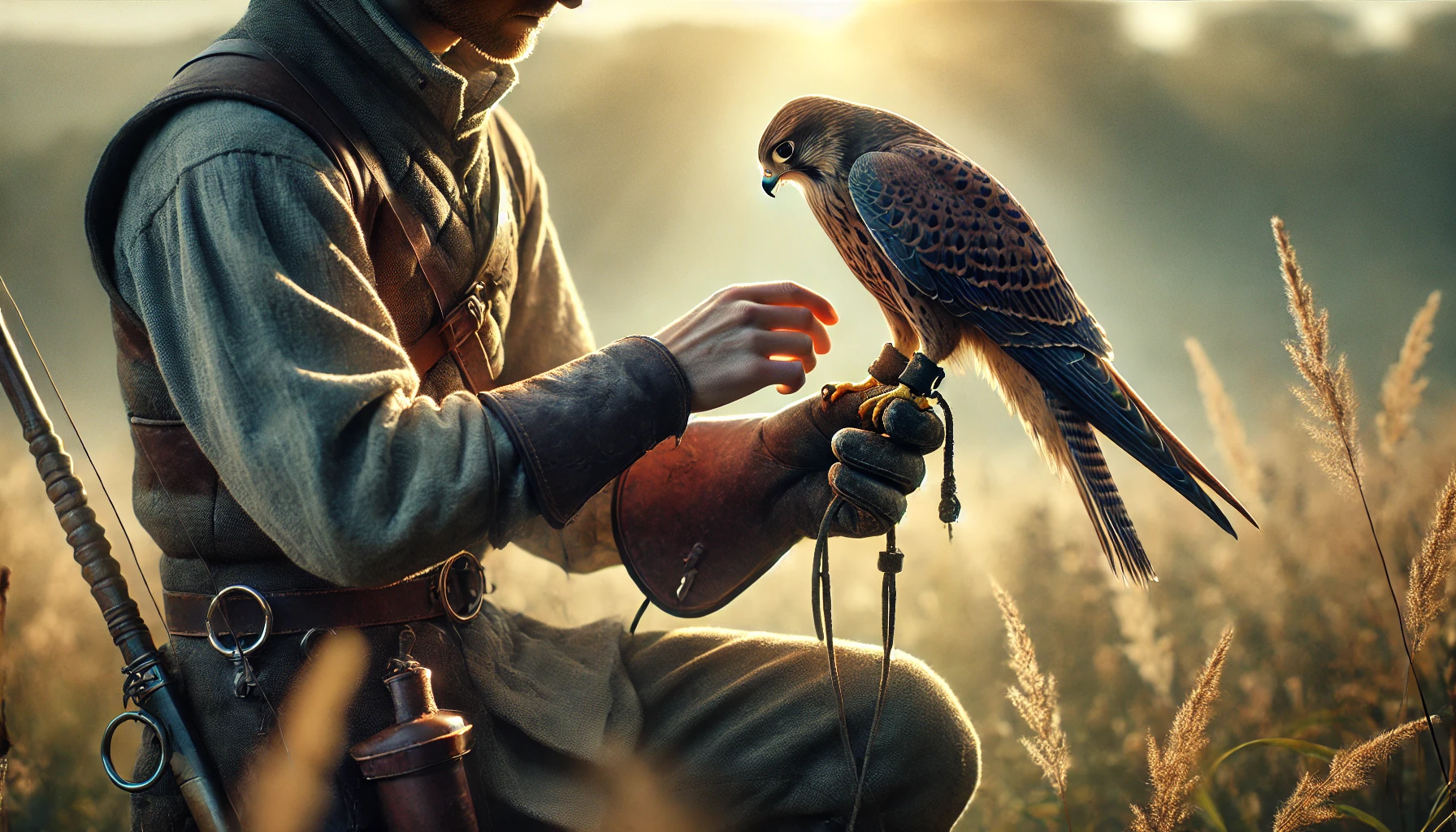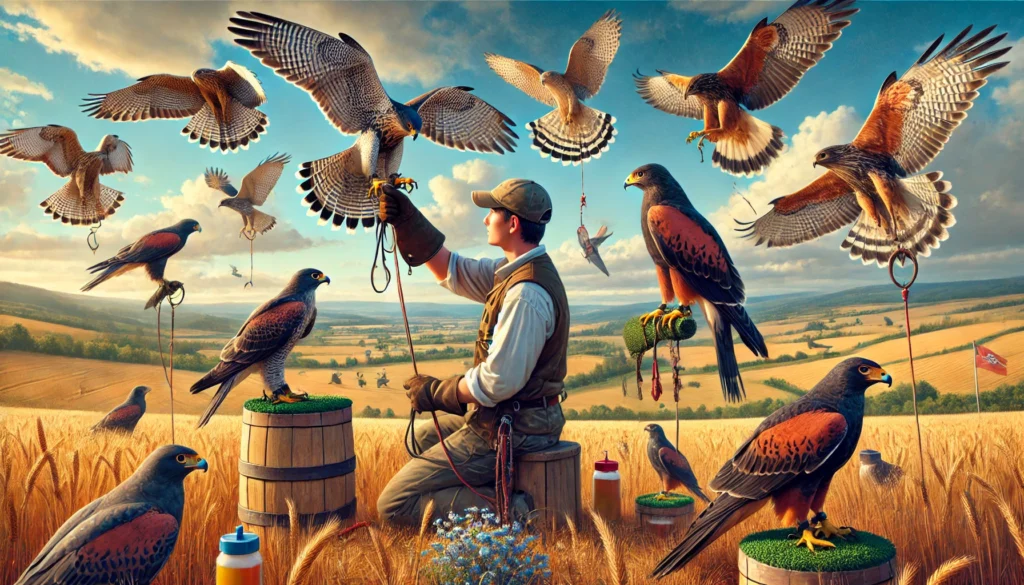Essential Manning Techniques in Falconry
- Hawk’s Relationships: Understanding the social interactions between falcon, owner, and surroundings.
- Habituation: Gradually getting young birds used to humans and the environment.
- Tethering Practices: Properly securing the falcon to ensure safety and comfort.
- Hooding Techniques: Using hoods to keep the falcon calm during transportation and in unfamiliar settings.
- Weight Management: Monitoring the falcon’s diet to maintain the ideal flying weight.
- Training Equipment: Utilizing essential tools like gloves, leashes, and perches.
- Behavioral Observation: Recognizing and interpreting the falcon’s body language and behaviors.
- Health Monitoring: Routine check-ups to keep the falcon in optimal health.
- Interactive Sessions: Engaging the falcon in daily training exercises and simulation hunts.
- Positive Reinforcement: Encouraging desired behaviors through rewards and treats.
- Progress Tracking: Keeping records of training sessions and milestones.
These key techniques will help you build a strong and trusting bond with your falcon, making your falconry experience both enjoyable and successful.
Discovering the Art of Manning Techniques in Falconry
Imagine you’re in a cozy Irish village, sipping a warm cup of tea by the fireplace. As you glance out the window, you notice an experienced shepherd calmly guiding his flock of sheep across a sprawling green field. Just like that shepherd, falconers use a special set of skills called “manning techniques” to build a trusting relationship with their birds. But, instead of woolly sheep, we’re talking about majestic falcons.
Welcome to Learn Falconry, where our passion is to help you master the ancient and fascinating art of falconry. In this article, we’ll take you through some essential manning techniques, which are vital for both beginner and seasoned falconers. These techniques lay the foundation for training your bird, ensuring it is calm, comfortable, and ready for the skies.
By understanding and practicing these techniques, you’ll soon find yourself mimicking that skilled shepherd, effortlessly guiding your falcon’s every move. Stick around, and we’ll unravel the secrets behind successful falcon training, making the experience rewarding and enriching for both you and your feathered companion.
So, ready your glove and open your mind as we delve into the captivating world of manning techniques in falconry!
Effective Manning Techniques in Falconry
Manning falcons is a crucial part of falconry, a practice that has its roots dating back thousands of years. Learn more about the history of falconry here. Manning involves training the falcon to accept the presence of humans and become comfortable with the falconer’s handling. By mastering various manning methods, you create a strong bond with your falcon, ensuring a successful partnership. Here’s everything you need to know about manning techniques.
Understanding Manning Falcons
Manning falcons is about building trust. When you bring a new falcon into your care, it can be a stressful experience for the bird. This is where the manning techniques come into play. The primary goal is to gradually expose the falcon to human presence and handling without causing it undue stress. This process requires patience, consistency, and a gentle approach.
The Basics of Manning Techniques
There are several manning methods used to train falcons, and each has its unique benefits:
- Hooding: Using a hood to cover the falcon’s eyes can reduce stress by minimizing visual stimuli. A well-fitted hood is essential, and you can find different types in our guide on types of hoods here.
- Taming Perches: Placing the falcon on tame perches in a low-traffic area helps it acclimate to its new environment. This method also allows the bird to feel safe while gradually sensing the presence of humans. Check out various perches and stands suitable for this purpose.
- Hand Feeding: Feeding the falcon by hand is another effective manning technique. This encourages the bird to associate its handler with positive experiences, reinforcing trust. Learn more about falcon nutrition in our nutrition section.
- Carrying: Regularly carrying the falcon on your glove helps it get accustomed to being held and moved around. Using a high-quality falconry glove ensures both comfort and safety for you and the bird.
- Introducing Equipment: Gradually introducing the necessary falconry gear, such as jesses, leashes, and bells, makes the falcon more comfortable with the objects it will encounter regularly. Learn more about essential falconry kits here.
Advanced Manning Methods
Once your falcon is comfortable with basic handling, you can advance to more complex manning methods. These might include:
Training with Lures: Using lures to train falcons simulates hunting and helps in conditioning. This technique can also be used to improve the bird’s fitness. Learn more about lure flying techniques here.
Free Flight Training: Allowing the falcon to fly freely, under controlled conditions, helps in honing its natural hunting skills. Find tips on free flight techniques.
Creance Training: This involves flying the falcon on a long leash called a creance. It helps in training the falcon to return to the handler. Discover more about creance training techniques.
Behavioral Conditioning: Using techniques like positive reinforcement, clicker training, and recalls to shape the falcon’s behavior effectively. Explore advanced training methods here.
Manning Falcons for Different Environments
Training a falcon in various environments helps in making it adaptable. Whether it’s urban settings or rural landscapes, environmental training ensures the falcon is comfortable and responsive in any scenario. Learn more about training in different environments.
Utilizing these manning techniques thoughtfully can create a strong bond between you and your falcon, ensuring a rewarding falconry experience. For those interested in delving deeper into advanced techniques and strategies, our guide on advanced falconry techniques can be an excellent resource.
Manning Techniques in Falconry
Manning is one of the fundamental techniques in falconry. It involves the initial process of getting a bird of prey comfortable with its new surroundings, including the falconer. Here are some key aspects of the manning process, illustrated with data, examples, and tables to enrich your understanding and make learning more engaging.
Initial Housing and Equipment
Housing
Providing a comfortable and safe environment is the first step. Falcons are typically housed in mews, aviaries, or temporary housing suitable for their size and type.
- Mews Size Recommendations (in meters)
- Single Falcon: 2 x 2 x 2.5
- Pair of Falcons: 3 x 2 x 2.5
Equipment
Essential equipment for manning includes jesses, swivels, leashes, and hoods. These tools help in handling and training the bird safely.
- Standard Equipment List
- Jesses: Leather straps attached to the bird’s legs.
- Swivel: Connects the jesses to the leash.
- Leash: Used to tether the bird.
- Hood: Keeps the bird calm during handling.
Habituation Process
Handling
The falcon must get used to being handled, for which regular and gentle handling sessions are crucial.
- Handling Frequency
- Daily: 1-2 hours of interaction
- Gradual increase: From 10 minutes to 30 minutes over a few weeks
Feeding on the Glove
Encouraging the bird to eat while perched on the falconer’s glove is critical.
- Feeding Schedule
- Week 1: Small, frequent meals by hand
- Week 2 and beyond: Regular feeding times
Behavioral Training
Perch Training
Teaching the bird to perch calmly is an essential part of manning.
- Perching Data
- Perch Type: Bow perch or block perch
- Perch Size: 2-3 times the bird’s height
Socialization and Environmental Exposure
Introducing the falcon to various environments and ensuring it is comfortable around people and noise.
- Exposure Sessions
- Week 1: Quiet areas, minimal distractions
- Week 2: Gradual introduction to busier environments
Monitoring Progress
Weight Management
Keeping a bird at its ideal flying weight ensures it remains healthy and responsive.
- Weight Tracking Table (grams)
| Week | Target Weight | Actual Weight |
|---|---|---|
| 1 | 700 | 750 |
| 2 | 700 | 720 |
| 3 | 700 | 700 |
Health Check
Regular veterinary checks and daily health monitoring help in recognizing any issues early.
- Health Assessment Checklist
- Clear eyes
- Bright plumage
- Healthy appetite
- Active and alert behavior
Techniques to Ensure Successful Manning
Positive Reinforcement
Using rewards like food treats and gentle praise motivates the falcon to perform desired behaviors.
Consistency
Regular, predictable routines help the bird adapt quickly and reduce stress.
Remember, successful manning sets the foundation for all future training and activities in falconry. Happy training with Learn Falconry!
Key Takeaways on Manning Techniques
Mastering manning techniques is essential for building a strong bond between a falcon and its handler. By understanding and applying proper manning methods, you ensure that the bird becomes comfortable, confident, and cooperative. Remember, patience and consistency are key. With these techniques, you not only enhance your falconry skills but also create a lasting partnership with your majestic bird. Happy flying with Learn Falconry!



